|
W43A (IRAS 18450-0148, OH 31.0 +0.0) -- a water fountain star
 | Monitoring of 1.3cm H2O maser spectra of 3 water fountain stars IRAS 16342-3814, IRAS 19134+2131 and
W 43A revealed variations as short as one
month. No maser feature velocity shift was found to be > 1km/s. The varying spectral features seemed to be
stable at several discontinuous fixed velocities for at least a few
years. The apparent symmetry in the H2O spectra allows determination of
the central velocities and suggests bipolar geometry. H2O maser velocity spreads are
dV = 130, 132, 180 km/s (disagree to the spectral
plots!?) and central velocities are Vlsr = +43.2+-0.9, -67.4+-0.4
and +33.6+-1.0 km/s for the 3 stars respectively.
(from Likkel et al.,1992A&A...256..581L)
(figure: upper 3 col -- variation of
red half of H2O masers; lower 3 col -- variation of blue half of H2O masers.)
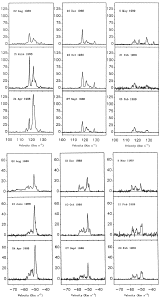 |
 | The ATCA/VLA OH 1612 MHz maser survey to the northern sky found 286 OH-masing
objects, 161 of them are new detections. Three water fountain stars were
also observed: IRAS 18460-0151(img58), IRAS 18286-0959(img54) and IRAS 18450-0148(img57).
(from Sevenster et al., 2001A&A...366..481S)
(figure: OH 1612 MHz maser line profile
of IRAS 18460-0151. X: km/s, Y:
Jy)
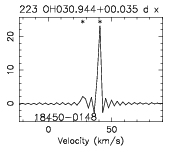 |
 | IRAS 18450-0148 has a phase-lag distance of 2.6 kpc. VLBA
observation of OH and H2O masers are present. Vlsr = 34 km/s (from OH, H2O and SiO masers). The OH
masers show a variation period of 400 days. The
apparent velocity separation of maser features are dV(OH)=9 km/s
and dV(H2O)=90 km/s, together with proper
motion, yielding a spatial H2O maser jet velocity of
145+-20 km/s. The OH maser region size is 0.25" (=650 AU)
while the H2O maser region size is larger: 0.65"
(=1700 AU), which is also larger than typical value of 10-100 AU for evolved stars.
H2O maser spots in both group align linearly
(with length of 250-350 AU and width of 20 AU). The dynamical age of the H2O masers
is ~28 yr, while the H2O masers are known to exist in W43A for
at least 25 years. It is possibly a bipolar jet created in an
OH/IR star. (from Imai, 2002Natur.417..829I)
(figure: left -- velocity coded OH +
H2O maser spatial distribution; right -- precessing jet model fit to the cockscrew jets)
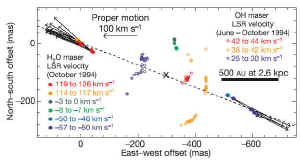 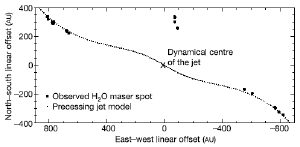 |
 | VLBA observation of SiO masers in W43A showed a
slow biconical outflow. The maser spot clustered in two groups separated by
~10mas (26 AU). The detection of SiO masers indicates the
mass loss is still going on. The H2O masers are re-observed with VLBA, and the precessing jets are still there
and have persisted for 8 years. (from Imai et al.,
2005ApJ...622L.125I)
(figure: a -- re-observed H2O maser
distributioin; b -- SiO maser distribution; c
-- conical SiO maser outflow model; d -- comparison of SiO
maser with 7mm continuum.)
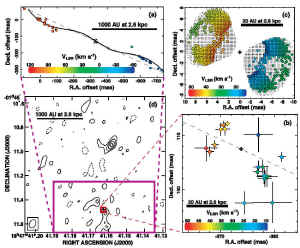 |
 | The 22 GHz H2O maser is searched for 85
post-AGB candidates using the Tidbinbilla 70m radio telescope between 2003
April to 2004 April. There are 21 detections.
Also present Mopra observations of 86 GHz SiO masers
to a sub-sample. Five stars were found to show high velocity H2O maser lines
and are water fountain star candidates, including W43A
(their source name: v223).
(from Deacon et al., 2007ApJ...658.1096D)
(figure: left -- H2O maser
(in -50~100 km/s range) and OH 1612 GHz maser spectra of W43A; right
-- H2O masers in (-80~0km/s) and (60~140km/s) ranges for W43A.)
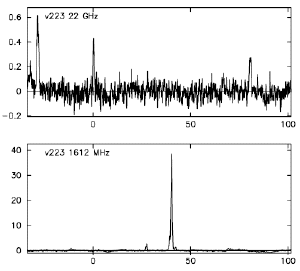 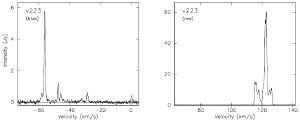 |
 | |
|
![]()